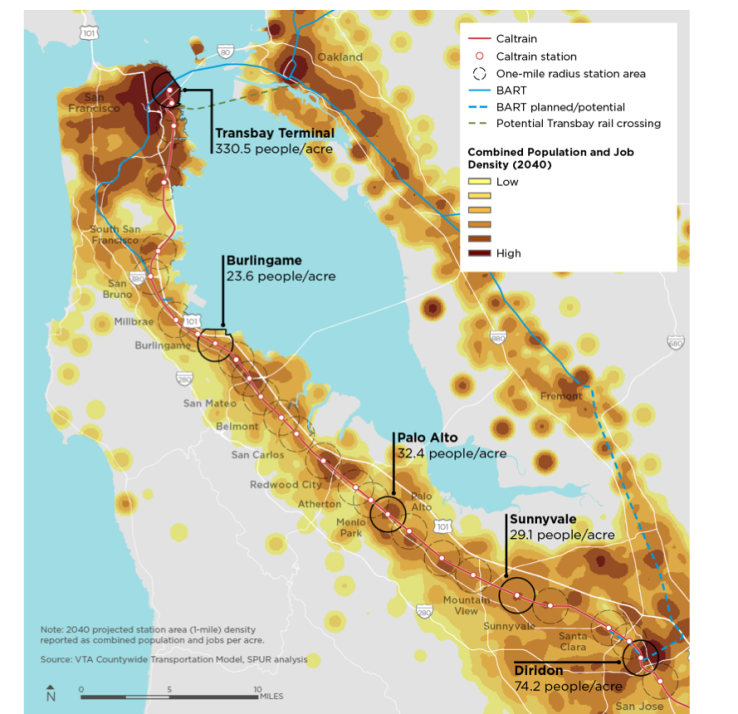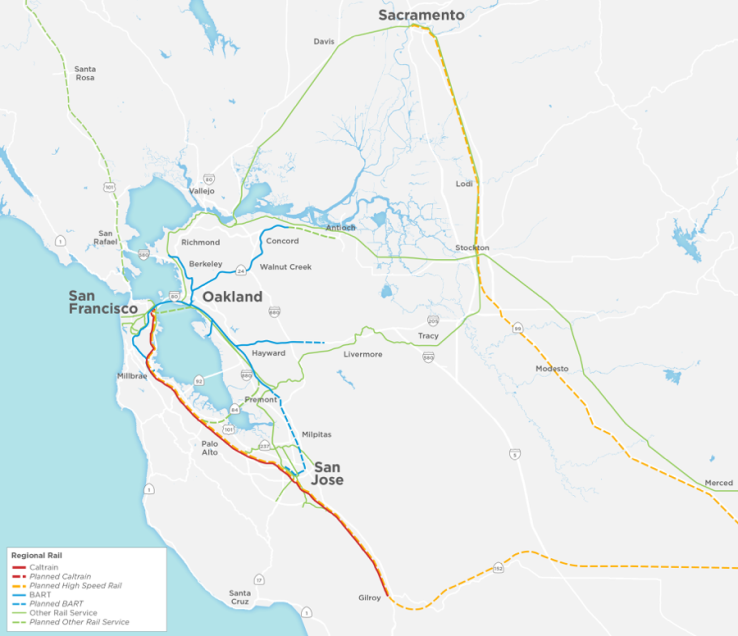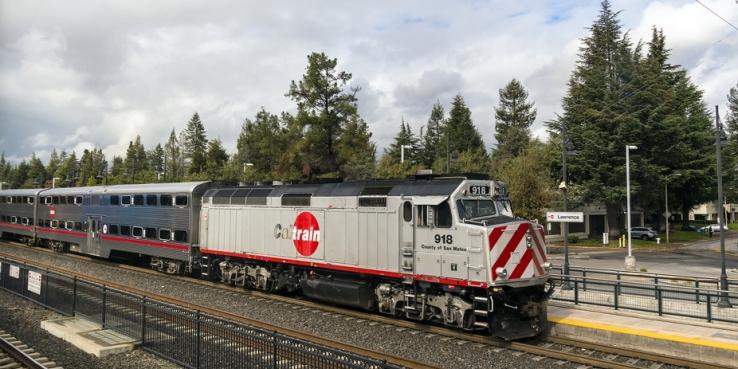This is an unbelievably exciting time for Caltrain, Silicon Valley’s railroad. First came the good news that Caltrain’s hard-fought federal funding for electrification will come through; now leaders and the public can embark on designing the Caltrain of the future. Finishing the $2.25 billion modernization project will mark the beginning of a completely new era for the Caltrain Corridor. Caltrain is transitioning from a diesel railroad focused on commute-hour service to — if we do things right — a reliable all-day transit system running on clean energy. SPUR described this bright future in the Caltrain Corridor Vision Plan.
It’s time to prepare for this new era. That’s why we’re glad to see that Caltrain has begun the process of developing a business plan, a key recommendation in SPUR’s Vision Plan. The stated goals of Caltrain’s business plan are to:
- Identify the additional capital projects and services needed to fully realize the public investment in electrification.
- Develop cost, revenue and funding targets that support improved services and ensure ongoing financial stability.
- Define opportunities for the long-term expansion of the Caltrain system.
- Engage with local, regional and state initiatives to secure new funding.
Developing a business plan may seem like an unusual activity for a public transit agency, but Caltrain is about to undergo a major change that deserves a high level of strategic thinking. Once Caltrain is electrified (currently scheduled for 2021), the railroad’s business model will transform: Costs, revenues and the objectives that drive decision-making will all completely change. There will be another pivot point once high-speed rail starts running on the Caltrain corridor, scheduled to begin in 2025.
We think the business plan is critical and deserves our best thinking and our full support. There may be an inclination to use the business plan to solve immediate funding problems, but we think that it should focus on the next 10 to 20 years. Here are five important questions SPUR expects the business plan to tackle:
1. What should Caltrain’s service pattern be after electrification?
Electrification is a chance to design a Caltrain service pattern from scratch: How frequently will trains run? Where should they stop? What is the balance of local trains and express trains? A service pattern for electrified Caltrain service does not yet exist, either for the opening day of electrified service or for after high-speed rail service begins in the corridor.
Today’s haphazard-seeming Caltrain service pattern can now become a more regular “clockface” schedule where trains leave hubs at predictable intervals (such as every 10 minutes), all day long. To date, the only study of electrified service patterns has taken placed during the Caltrain electrification environmental process and the current high-speed rail environmental review process for the corridor. Caltrain would benefit from an opportunity to plan service patterns and consider financial outcomes in a forum that isn’t as constrained.
A set of studies in 2013 tested running six Caltrain trains and four high-speed rail trains per hour during peak hours of service. There is potential to run far more than six Caltrain trains, but it will take some planning and upgrades to the system. (For a sampling of potential future schedules for Caltrain and high-speed rail, see Appendix A of the Caltrain Corridor Vision Plan).
Off-peak service — the trains that run outside of rush hour — has the most opportunity for growth: Most stations in the corridor only see one train per hour. Frequent midday or evening service would serve new markets, bringing new riders and helping Caltrain become a true all-day transit service.
The business plan should evaluate the real benefits and tradeoffs between different types of schedules. Some schedules cost less to operate, some attract more riders and some can accomplish both. SPUR’s Vision Plan found that over time, Caltrain could serve five times as many people as it does today.
Growing Station Areas Will Need More Caltrain Service

With more trains throughout the day, riders will be able to travel between Caltrain Corridor cities without planning their day around a train schedule. As these cities grow (the map shows estimated 2040 densities), Caltrain will become an essential way to move among them. Source: SPUR, Caltrain Corridor Vision Plan.
2. What does Caltrain need to do and buy to make the new service plan work?
Beyond electrification, there is much more system improvement that we will need to fund. Basic investments include: longer platforms so Caltrain can operate 8-car trains (currently, it can only operate 5- to 6-car trains), wider platforms at some stations (to accomodate more passengers); new train cars, and a big enough fleet of electric trains for the whole fleet to be electric from San Francisco to San Jose. (At least 20 percent of the diesel fleet is expected to remain in service when electrified service starts). Maintenance of the diesel fleet, which will continue to run until electrification, also requires funding. Further investments that enable us to add service include signal system and other technology upgrades, new passing tracks, new or expanded maintenance facilities and station upgrades. Grade separations will also be important to mitigate community and traffic impacts caused by increases in train service along the corridor. The business plan should help create a targeted shopping list, so Caltrain buys the precise system improvements that it truly needs. It should also identify packages of investments that will make Caltrain a far more useful and cost-effective service to run in the long term.
The California High-Speed Rail Authority will be making limited investments in the corridor for the Caltrain/high-speed rail system to work. However high-speed rail has limited funding; the business plan should tell us what additional upgrades and projects will make for a successful blended system, one that serves both state-wide and regional mobility needs and includes more than six Caltrains per hour.
3. How should the corridor fund Caltrain service (both operating costs and maintenance)? Where should money for new Caltrain infrastructure come from?
Caltrain’s biggest business problem today is a lack of dedicated funding. Unlike BART or VTA or AC Transit, Caltrain has to find money to operate its service each and every year and relies on contributions from the three counties that own the railroad (Santa Clara, San Mateo and San Francisco, who comprise the Peninsula Joint Powers Board that operates Caltrain). The same goes for capital funds: The railroad relies on grants and contributions from the three counties.
This kind of fiscal instability should not continue into the electrified era, and it doesn’t have to. Beyond fares, the business plan should develop new financial models and identify reliable sources of funding that will pay for the level of service the region will need. In the Vision Plan, we identify the opportunity to grow both broad-based funding (such as sales taxes) and more specific funding (such as property-based or business-based fees and taxes). Sources could also include thinking strategically about how to best use Caltrain’s real estate (such as stations, crew facilities, maintenance yards and land around stations).
Fare revenue also has a growing role to play. An attractive electrified schedule with more trains means that revenue from fares could potentially cover more of the system’s operating costs. While the fixed costs of running electrified trains will be higher than today, the marginal cost of running an additional train should decrease. Caltrain has been on a path to greater efficiency: while county contributions per passenger are going down ($1.00 per passenger today, down from $4.90 in 2005), fare revenue per passenger has been going up (to $4.50 today, up from $3.20 in 2005). With additional service, Caltrain should be able to increase ridership, fare revenue and access for those who can’t afford standard fares — all at the same time.
Another source of revenue is public-private partnerships. While a private concessionaire runs Caltrain today, it doesn’t receive private investment. A public-private partnership could be a strategic way to make a major investment in the railroad and should be explored in the business plan. (For example, a private operator invests in the capital projects the railroad needs in exchange for some of the revenue from operations.)
4. How can Caltrain service connect to the rest of the region?
Despite Caltrain’s day-to-day challenges with keeping service running reliably and funding near-term projects, cities, transportation agencies and planners in the region are all anticipating Caltrain’s the future. For decades, leaders have planned to extend Caltrain to downtown San Francisco; the downtown extension, or DTX, project would bring Caltrain to the Transbay Transit Center — the densest job center in the region, adjacent to BART stations.
SPUR and many others, have also promoted extending Caltrain service across the San Francisco Bay in a new tunnel that would connect with the Capitol Corridor in the East Bay and with BART in downtown Oakland. Extending Caltrain service across the Dumbarton Rail Bridge (which the Caltrain Joint Powers Board owns) has also been under discussion for decades. (A new study of transit in the Dumbarton Corridor is underway). These crossings and other rail network connections will be discussed in the upcoming State Rail Plan. The business plan should answer the question of how these extensions of service, or others, would affect Caltrain’s ridership and markets, its capital and operating costs, and its revenue.
The Caltrain Business Plan is also needed urgently to inform the design of specific stations, in particular, 4th and King, the current northern terminus in San Francisco, and Diridon Station, the future major train hub and new urban neighborhood, in San Jose. For example, we shouldn’t make decisions about whether high-speed rail should be at-grade or aerial at Diridon Station without asking what type of service riders will need and which type of infrastructure can best deliver it. Our infrastructure should be right-sized to the type of service we want and need and should utilize our station space (railyards and platforms) as effectively as possible. If not, we risk over-building and over-spending.
The Future Statewide Rail Network

In the future, Caltrain service will be integrated into a statewide rail network, opening up entirely new markets for the railroad. Source: SPUR, Caltrain Corridor Vision Plan.
5. What steps will future-proof Caltrain and make it a U.S. innovator?
Caltrain is facing the same forces and trends as all public transit: growing maintenance costs, decreasing revenue, and increasing competition from privately operated transit, door-to-door car services and on-demand transportation. Perhaps more importantly, the agency doesn’t have control over the many things that shape its ridership: building more housing and jobs near stations, improving access to and from stations or even the price of gas.
The business plan is an opportunity for the Bay Area to learn what works and what doesn’t from railroads around the world and develop an agenda to make this corridor an innovator among U.S. railroads.
Currently, leaders around the region are making decisions with long-term implications without a shared picture of the future of Caltrain. The business plan can be a vehicle to help the Caltran Corridor find its north star and navigate the years ahead.
